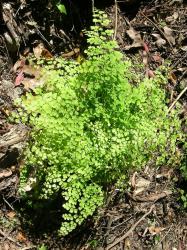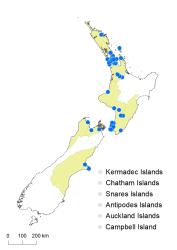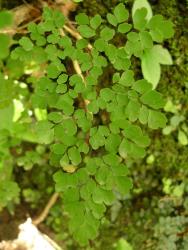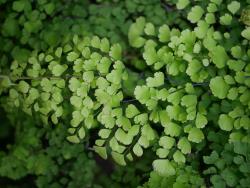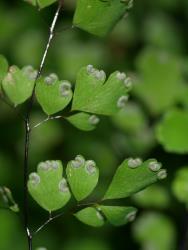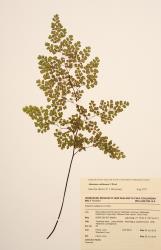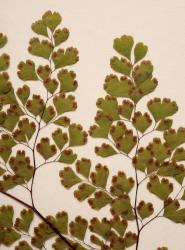- ≡ Adiantum cuneatum Langsd. & Fisch., Pl. Voy. Russes Monde, Icon. Fil. 23, t. 26 (1810) nom. illeg., non Adiantum cuneatum G.Forst. 1786
Rhizomes short-creeping, up to 100 mm long (in herbarium specimens), 2–3.5 mm diameter, with stipes closely inserted; bearing scales; stolons and tubers absent. Rhizome scales narrowly ovate, 1–2.5 mm long, 0.2–0.4 mm wide, orange-brown, concolorous. Fronds 125–680 mm long. Stipes 45–430 mm long, dark brown, polished, glabrous except for a few scattered scales proximally. Rachises dark brown, sulcate, polished, glabrous. Laminae 3–4-pinnate, or rarely 5-pinnate, ovate or broadly ovate or elliptic, 80–350 mm long, 30–270 mm wide, mid-green on both surfaces, herbaceous, glabrous. 7–10 pairs of divided primary pinnae below pinnate apex, widely spaced especially proximally, ovate; the longest at or near the base, 25–155 mm long, 12–85 mm wide, apices acute or obtuse, bases stalked, divided into secondary pinnae. 2–7 pairs of secondary pinnae on proximal primary pinnae divided into tertiary pinnae; the longest secondary pinnae ovate, 12–55 mm long, 7–38 mm wide, apices obtuse, bases stalked, divided into tertiary and sometimes quaternary segments. Longest ultimate lamina segments flabellate, longer than broad, 4–17 mm long, 2–17 mm wide, apices rounded, often divided into two or more lobes, bases stalked, with stalks attached centrally. Reflexed lamina flaps reniform, glabrous.
Adiantum raddianum is distinguished by its 3–4-pinnate fronds, flabellate ultimate segments with the stalks attached centrally, glabrous rachises and laminae, reniform and glabrous “indusia”, and the green colour of the abaxial lamina surface. It is easily confused with the indigenous A. aethiopicum, but distinguished by its ultimate lamina segments, which are longer than broad, and at least some are more deeply incised than the indusial notches, forming two or more distinct lobes. The ultimate segments in A. aethiopicum are generally broader than long, and entire or shallowly incised, especially at the point of attachment of the “indusia”. There is also a true creeping rhizome in A. raddianum, whereas A. aethiopicum has a more or less erect rhizome with long-creeping stolons.
North Island: Northland, Auckland, Taranaki, Southern North Island.
South Island: Western Nelson, Sounds-Nelson, Canterbury.
Altitudinal range: 0–200 m.
In the North Island, Adiantum raddianum occurs from the Bay of Islands to Wellington, most commonly near urban areas, and in the South Island it is recorded from Golden Bay, Nelson, the Marlborough Sounds, and Christchurch. There is also a very early record from near Akaroa, collected by J.B. Armstrong in 1866 (CHR 633287). It is apparently becoming increasingly common and widespread.
Occurs naturally in tropical regions of Central and South America. Naturalised in Africa (Crouch et al. 2011), Ascension Island, St Helena, Macaronesia, Asia (Fraser-Jenkins et al. 2017), Vanuatu (Nakamura 2008) and Hawai‘i (Palmer 2003).
Adiantum raddianum grows on the ground in open areas, or under light, broadleaved forest, beech forest, or under introduced trees. It is found on river banks and cliffs, on track banks, and on coastal hillsides. It grows on greywacke, limestone, sandstone, scoria, and volcanic soils, as well as on concrete block walls and in other urban habitats.
Brownsey (1981). Voucher AK 129354, 1971. However, the Armstrong record from Akaroa (cited above) suggests that the species has been in New Zealand for much longer, perhaps mistakenly identified as A. aethiopicum.
From a comparison of rbcL sequences, Bouma et al. (2010) noted that New Zealand plants might be misidentified. However, this stemmed from incorrectly labelled sequences on GenBank, and an rbcL sequence from New Zealand material matches that of plants labelled as Adiantum raddianum by Hirai et al. (2016) (Perrie unpub.).



